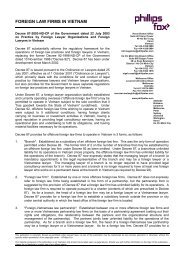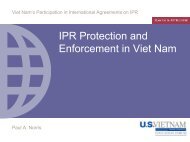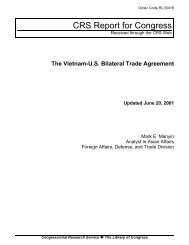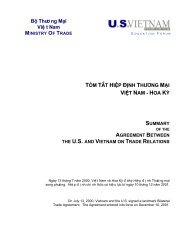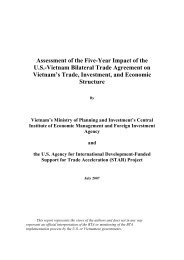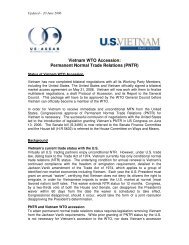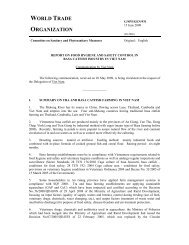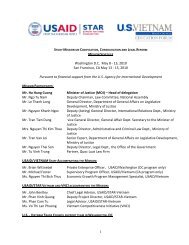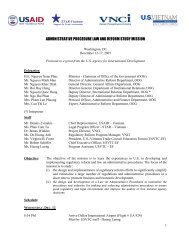Climate risks and adaptation in Asian coastal megacities: A synthesis
Climate risks and adaptation in Asian coastal megacities: A synthesis
Climate risks and adaptation in Asian coastal megacities: A synthesis
- No tags were found...
Create successful ePaper yourself
Turn your PDF publications into a flip-book with our unique Google optimized e-Paper software.
1IntroductionBackground <strong>and</strong> RationaleAs recent weather events have illustrated, <strong>coastal</strong>areas <strong>in</strong> both develop<strong>in</strong>g <strong>and</strong> more <strong>in</strong>dustrializedeconomies face a range of <strong>risks</strong> related to climatechange (IPCC 2007a). Anticipated <strong>risks</strong> <strong>in</strong>clude anaccelerated rise <strong>in</strong> sea level of up to 0.6 meters ormore by 2100, a further rise <strong>in</strong> sea surface temperaturesby up to 3° C, an <strong>in</strong>tensification of tropical<strong>and</strong> extra tropical cyclones, larger extreme waves<strong>and</strong> storm surges, altered precipitation <strong>and</strong> runoff,<strong>and</strong> ocean acidification (Nicholls et al. 2007).The Intergovernmental Panel for <strong>Climate</strong> ChangeFourth Assessment Report (IPCC 2007a) po<strong>in</strong>ts toa range of outcomes under different scenarios <strong>and</strong>identifies a number of hotspots—<strong>in</strong>clud<strong>in</strong>g heavilyurbanized areas situated <strong>in</strong> the large low-ly<strong>in</strong>gdeltas of Asia <strong>and</strong> Africa—as especially vulnerableto climate-related impacts. For <strong>in</strong>stance, by 2080,the report po<strong>in</strong>ts out, many millions more peoplemay experience floods annually due to sea levelrise (IPCC 2007a). More frequent flood<strong>in</strong>g <strong>and</strong> <strong>in</strong>undationof <strong>coastal</strong> areas can also result <strong>in</strong> various<strong>in</strong>direct effects, such as water resource constra<strong>in</strong>tsdue to <strong>in</strong>creased sal<strong>in</strong>ization of groundwater supplies.Human-<strong>in</strong>duced pressures on <strong>coastal</strong> regionscan further compound these effects.The location of many of the world’s major cities—suchas Mumbai, Shanghai, Jakarta, Lagos,<strong>and</strong> Kolkata—around coastl<strong>in</strong>es, rivers, <strong>and</strong> deltasprovides an <strong>in</strong>dication of the population <strong>and</strong> assetsat risk. Thirteen of the world’s 20 largest citiesare located on the coast <strong>and</strong> more than a third ofthe world’s population lives with<strong>in</strong> 100 miles ofa shorel<strong>in</strong>e. Low-ly<strong>in</strong>g <strong>coastal</strong> areas—def<strong>in</strong>ed asareas along the coast that are less than 10 metersabove sea level—represent 2 percent of the world’sl<strong>and</strong> area, but conta<strong>in</strong> 13 percent of the urban population(McGranahan et al. 2007). A recent study of136 port cities showed that the population exposedto flood<strong>in</strong>g l<strong>in</strong>ked with a 1-<strong>in</strong>-100-year event islikely to rise dramatically, from 40 million currentlyto 150 million by 2070 (Nicholls et al. 2008).Similarly, the value of assets exposed to flood<strong>in</strong>gis estimated to rise to $35 trillion, up from $3 trilliontoday. The study also shows that significant,<strong>in</strong>creas<strong>in</strong>g exposure is expected for the populations<strong>and</strong> economic assets <strong>in</strong> Asia’s <strong>coastal</strong> cities.In flood-prone cities such as Manila, potentialsea level rise <strong>and</strong> <strong>in</strong>creased frequency <strong>and</strong> <strong>in</strong>tensityof extreme weather events poses enormouschallenges on urban local bodies’ ability to adapt.Apart from their location, the scale of risk is also<strong>in</strong>fluenced by the quality of hous<strong>in</strong>g <strong>and</strong> <strong>in</strong>frastructure,<strong>in</strong>stitutional capacity with respect toemergency services, <strong>and</strong> the city’s preparednessto respond. The urban poor are most at risk fromexposure to hazards <strong>in</strong> <strong>coastal</strong> cities, as they tendto live <strong>in</strong> riskier urban environments (such asfloodpla<strong>in</strong>s, unstable slopes), tend to work <strong>in</strong> the<strong>in</strong>formal economy, have fewer assets, <strong>and</strong> receiverelatively less protection from government <strong>in</strong>stitutions(Satterthwaite et al. 2007).Despite its importance, few develop<strong>in</strong>g countrycities have <strong>in</strong>itiated efforts to <strong>in</strong>tegrate climatechange issues as part of their decision-mak<strong>in</strong>gprocess. Given the <strong>risks</strong> faced by <strong>coastal</strong> cities <strong>and</strong>the importance of cities more broadly as drivers of1



